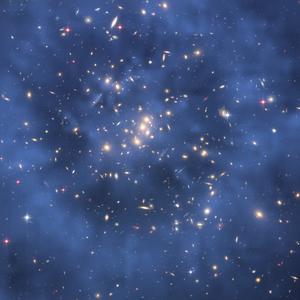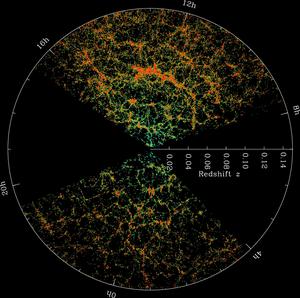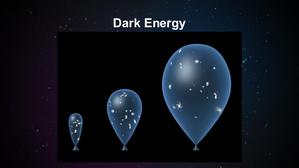Glossary term: Dark Matter
Description: Dark matter is a proposed form of matter that has mass, but is completely transparent and does not emit light. It has been postulated as a joint explanation for a variety of phenomena related to gravitational interactions.
Early evidence for the existence of dark matter came from galaxies in galaxy clusters, which were found to be moving at comparatively high speeds. Postulating additional mass served to explain why, in spite of their speeds, the galaxies in question were gravitationally bound to their cluster instead of escaping. Measurements by Vera Rubin and others of the speeds at which stars and gas orbit in disk galaxies led to a wider acceptance of the concept of dark matter: there, the usual laws of gravity require considerable mass in addition to the visible matter in order to explain the observed high rotation speeds. More recently, gravitational lensing observations have indicated considerable non-luminous mass in galaxy clusters.
In cosmology, the expansion history of the Universe points to there being more matter in the Universe than is accounted for in the form of luminous matter. The common explanation for the growth of structure in the early Universe also relies on the presence of dark matter. For these reasons, the standard cosmological models are referred to as "Lambda CDM models", where CDM stands for cold (slow-moving) dark matter.
The nature of dark matter is a topic of intense research and debate both in cosmology and particle physics. Evidence for dark matter remains indirect, relying on observations of the effects of dark matter's mass on luminous matter or light. Several proposals exist for species of as yet undetected elementary particles that could make up dark matter, but the experiments set up to find direct evidence for such candidate particles have not so far been successful. There are also alternative proposed explanations that claim to account for the relevant observations without the involvement of new particle species.
Related Terms:
See this term in other languages
Term and definition status: This term and its definition have been approved by a research astronomer and a teacher
The OAE Multilingual Glossary is a project of the IAU Office of Astronomy for Education (OAE) in collaboration with the IAU Office of Astronomy Outreach (OAO). The terms and definitions were chosen, written and reviewed by a collective effort from the OAE, the OAE Centers and Nodes, the OAE National Astronomy Education Coordinators (NAECs) and other volunteers. You can find a full list of credits here. All glossary terms and their definitions are released under a Creative Commons CC BY-4.0 license and should be credited to "IAU OAE".
If you notice a factual error in this glossary definition then please get in touch.
Related Media
Dark matter
Credit: NASA, ESA, M.J. Jee and H. Ford (Johns Hopkins University) credit link
License: CC-BY-4.0 Creative Commons Attribution 4.0 International (CC BY 4.0) icons
SDSS Redshift Map
Credit: M. Blanton and Sloan Digital Sky Survey credit link
License: CC-BY-4.0 Creative Commons Attribution 4.0 International (CC BY 4.0) icons
Related Activities
Dark matter & dark energy (Part 2) – Understanding the nature of dark matter and dark energy
astroEDU educational activity (links to astroEDU website) Description: Let's investigate the nature of dark matter and energy with gravitational lensing!
License: CC-BY-4.0 Creative Commons Attribution 4.0 International (CC BY 4.0) icons
Tags:
Experiment
, Invisible
Age Ranges:
12-14
, 14-16
, 16-19
, 19+
Education Level:
Informal
, Middle School
Areas of Learning:
Guided-discovery learning
, Interactive Lecture
, Modelling
, Problem-solving
Costs:
Medium Cost
Duration:
45 mins
Group Size:
Group
Skills:
Constructing explanations
, Developing and using models
, Engaging in argument from evidence
Dark matter and Dark energy (Part 1) – Discovering the main components of the Universe
astroEDU educational activity (links to astroEDU website) Description: Lets' investigate gravity, dark matter and dark energy with some very simple experiments!
License: CC-BY-4.0 Creative Commons Attribution 4.0 International (CC BY 4.0) icons
Tags:
Experiment
, Galaxies
Age Ranges:
12-14
, 14-16
, 16-19
, 19+
Education Level:
Informal
, Middle School
Areas of Learning:
Guided-discovery learning
, Interactive Lecture
, Modelling
, Observation based
, Other
, Problem-solving
Costs:
Low Cost
Duration:
45 mins
Group Size:
Group
Skills:
Constructing explanations
, Developing and using models
, Engaging in argument from evidence
, Planning and carrying out investigations












